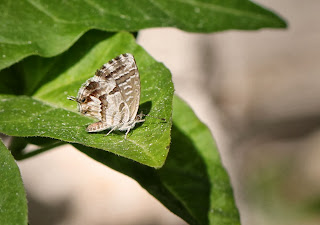Maltese Nature and the Question of Nurture:
by John Aldridge
 |
|
| Geranium Bronze. Photo: John Aldridge |
It’s mid morning. All the raptors that roosted on Malta overnight have left for Africa and the day’s expected influx is still on its way from Sicily. This when us volunteers have some time to ourselves. The Kennedy Memorial is not far from the hotel and the grounds are worth walking through. It’s not long before a tiny butterfly appears; it’s a Geranium Bronze, a relatively recent colonist. Then a bright
yellow one appears and settles briefly – a Clouded Yellow, probably migrating through. A white butterfly appears, it’s mottled underside shows it to be a Bath White.
 |
| The prehensile tail of the Chameleon is put to good use. Photo: John Aldridge |
Continuing along the path several grasshoppers jump to the side and instantly disappear because of their clever camouflage; it takes some effort to locate one and more difficult to photograph it before it jumps off and disappears again. A Chameleon creeps through a bush and looks at you (and something else in a different direction at the same time) in the hope that you won’t actually see it. Maltese Wall Lizards bask in the sun and just occasionally allow me to creep up with my camera.
 |
|
| Scarlet Darter perched on a rock. Photo John Aldridge |
The small stream reveals several male Scarlet Darter Dragonflies, their colour more vivid than anything on a printed page. There’s a blue Keeled Skimmer and several Yellow-veined Darters as well; the latter are also found well away from water.
Many Sea Squill are in flower. Their leaves have long since died but this is when the strong stem stands proud. It flowers from the bottom up so a single stem can hold seed heads at the bottom, small full blooms half way up and buds waiting to open to the sun at the top.
 |
| Sea Squill. Photo: John Aldridge |
There’s so much variety here, and when we are out raptor watching it’s easy to be sidetracked by a Praying Mantis, the scent of Wild Thyme, the constant ‘song’ of a Cicada, bats emerging at sunset and their final sortie at sunrise, or a Painted Lady flying round your head. With so much richness why are the birds under so much pressure from illegal hunting? Why is it legal to shoot Turtle Doves that are declining across Europe and why does hunting take place in Spring? Surely the birds should be allowed to take their place in the environment alongside the rest of Malta’s splendid flora and fauna. They are only here for a day or less and would never be able to have a negative impact on the environment.
Back to the ‘day job’ now and out for an evening shift. Let’s hope a few raptors make their southward flight over the island without facing a cloud of lead shot.
P.S. Raptors their were, including two Ospreys, and we heard no shots. However, we were diverted during our return to the hotel to pick up an injured Grey Heron that CABS had fished out of the sea. It had little fight left in it as it was carefully wrapped in Marcus’s tee-shirt for the journey to the vet. It died in my hands before we got there.
The work continues…………………
 |
| Sunrise at 5:57, 22nd September and the Raptor Camps are already in place. Photo: John Aldridge |
John Aldridge is a volunteer with the Environmental Records Center in Bristol and a keen naturalist and nature photographer. He has been coming to Malta for several years as a Raptor Camp and Spring Watch volunteer.


